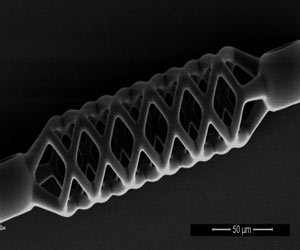- Home
- Editorial
- News
- Practice Guidelines
- Anesthesiology Guidelines
- Cancer Guidelines
- Cardiac Sciences Guidelines
- Critical Care Guidelines
- Dentistry Guidelines
- Dermatology Guidelines
- Diabetes and Endo Guidelines
- Diagnostics Guidelines
- ENT Guidelines
- Featured Practice Guidelines
- Gastroenterology Guidelines
- Geriatrics Guidelines
- Medicine Guidelines
- Nephrology Guidelines
- Neurosciences Guidelines
- Obs and Gynae Guidelines
- Ophthalmology Guidelines
- Orthopaedics Guidelines
- Paediatrics Guidelines
- Psychiatry Guidelines
- Pulmonology Guidelines
- Radiology Guidelines
- Surgery Guidelines
- Urology Guidelines
World's smallest stent developed for children with congenital urinary tract defects

Approximately one in every thousand children develops a urethral stricture, sometimes even when they are still a fetus in the womb. In order to prevent life-threatening levels of urine from accumulating in the bladder, pediatric surgeons like Gaston De Bernardis at the Kantonsspital Aarau have to surgically remove the affected section of the urethra and sew the open ends of the tube back together again. It would be less damaging to the kidneys, however, if a stent could be inserted to widen the constriction while the fetus is still in the womb.
Stents have been used to treat blocked coronary vessels for some time now, but the urinary tract in fetuses is much narrower in comparison. It's not possible to produce stents with such small dimensions using conventional methods, which is why De Bernardis approached the Multi-Scale Robotics Lab at ETH Zurich. The lab's researchers have now developed a new method that enables them to produce highly detailed structures measuring less than 100 micrometers in diameter, as they report in a recently published journal article.
Indirect 4D printing
"We've printed the world's smallest stent with features that are 40 times smaller than any produced to date," says Carmela De Marco, lead author of the study and Marie Sk?odowska-Curie fellow in Bradley Nelson's research group. The group calls the method they've developed indirect 4D printing. They use heat from a laser beam to cut a three-dimensional template - a 3D negative - into a micro mould layer that can be dissolved with a solvent. Next, they fill the negative with a shape-memory polymer and set the structure using UV light. In the final step, they dissolve the template in a solvent bath and the three-dimensional stent is finished.
It's the stent's shape-memory properties that give it its fourth dimension. Even if the material is deformed, it remembers its original shape and returns to this shape when warm. "The shape-memory polymer is suitable for treating urethral strictures. When compressed, the stent can be pushed through the affected area. Then, once in place, it returns to its original shape and widens the constricted area of the urinary tract," De Bernardis says.
But the stents are still a long way from finding the real-world application. Before human studies can be conducted to show whether they are suitable for helping children with congenital urinary tract defects, the stents must first be tested in animal models. However the initial findings are promising, "We firmly believe that our results can open the door to the development of new tools for minimally invasive surgery," De Marco says.

Disclaimer: This site is primarily intended for healthcare professionals. Any content/information on this website does not replace the advice of medical and/or health professionals and should not be construed as medical/diagnostic advice/endorsement or prescription. Use of this site is subject to our terms of use, privacy policy, advertisement policy. © 2020 Minerva Medical Treatment Pvt Ltd